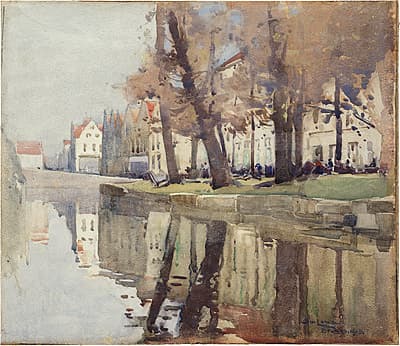
Sydney
LONG
Australia
1871
–
London
1955
England, Europe 1910-21; Australia 1921- 22; England 1922-25; Australia 1925-52; England from 1952
23.6 (h) x 27.4 (w) cm
signed and dated ‘SID LONG/ Bruges 1913’ lower right Art Gallery of New South Wales, Sydney, bequest of Mollie and Jim Gowing 2011
A simple alignment of medieval facades, bordered with generously foliaged trees reflected in the calm waters of a secondary canal in Bruges, is the subject of this small watercolour. Within these surroundings, Long depicted a peaceful canal-side setting, with a vague impression of people enjoying fine weather on the banks.
While in Belgium in August 1913, Long depicted the famous landmarks of Bruges, such as its belfry, but he was also inspired by anecdotal subjects, to which he gave a stately touch.In Bruges, because they are made from the same stone, the borders of the canals are physically and visually connected to the neighbouring buildings. This link creates a sense of unity and serenity in the city.
In this watercolour, the luminosity of the underlying paper, the transparency of the wash and the opacity of the pigment, all fundamental characteristics of water-based paint, work in unison to convey a typical Bruges scene of dark blue canal waters, which mirror the surrounding trees and buildings. Although painted during the height of summer, Long favoured an autumnal palette, together with red highlights for the rooflines and the more expected summer hues for grassy banks, bright sky and blue water. Beyond his brilliant use of colours he seemed, however, less interested in accuracy concerning colour, time and topography, than in conveying the ideal image of the perfect season. Just as in his views of Sydney Harbour, Long revealed in Bruges 1913 his ongoing ambition to create timeless and dignified paintings.
Anne Gerard-Austin
A simple alignment of medieval facades, bordered with generously foliaged trees reflected in the calm waters of a secondary canal in Bruges, is the subject of this small watercolour. Within these surroundings, Long depicted a peaceful canal-side setting, with a vague impression of people enjoying fine weather on the banks.
While in Belgium in August 1913, Long depicted the famous landmarks of Bruges, such as its belfry, but he was also inspired by anecdotal subjects, to which he gave a stately touch.In Bruges, because they are made from the same stone, the borders of the canals are physically and visually connected to the neighbouring buildings. This link creates a sense of unity and serenity in the city.
In this watercolour, the luminosity of the underlying paper, the transparency of the wash and the opacity of the pigment, all fundamental characteristics of water-based paint, work in unison to convey a typical Bruges scene of dark blue canal waters, which mirror the surrounding trees and buildings. Although painted during the height of summer, Long favoured an autumnal palette, together with red highlights for the rooflines and the more expected summer hues for grassy banks, bright sky and blue water. Beyond his brilliant use of colours he seemed, however, less interested in accuracy concerning colour, time and topography, than in conveying the ideal image of the perfect season. Just as in his views of Sydney Harbour, Long revealed in Bruges 1913 his ongoing ambition to create timeless and dignified paintings.
Anne Gerard-Austin
A simple alignment of medieval facades, bordered with generously foliaged trees reflected in the calm waters of a secondary canal in Bruges, is the subject of this small watercolour. Within these surroundings, Long depicted a peaceful canal-side setting, with a vague impression of people enjoying fine weather on the banks.
While in Belgium in August 1913, Long depicted the famous landmarks of Bruges, such as its belfry, but he was also inspired by anecdotal subjects, to which he gave a stately touch.In Bruges, because they are made from the same stone, the borders of the canals are physically and visually connected to the neighbouring buildings. This link creates a sense of unity and serenity in the city.
In this watercolour, the luminosity of the underlying paper, the transparency of the wash and the opacity of the pigment, all fundamental characteristics of water-based paint, work in unison to convey a typical Bruges scene of dark blue canal waters, which mirror the surrounding trees and buildings. Although painted during the height of summer, Long favoured an autumnal palette, together with red highlights for the rooflines and the more expected summer hues for grassy banks, bright sky and blue water. Beyond his brilliant use of colours he seemed, however, less interested in accuracy concerning colour, time and topography, than in conveying the ideal image of the perfect season. Just as in his views of Sydney Harbour, Long revealed in Bruges 1913 his ongoing ambition to create timeless and dignified paintings.
Anne Gerard-Austin
